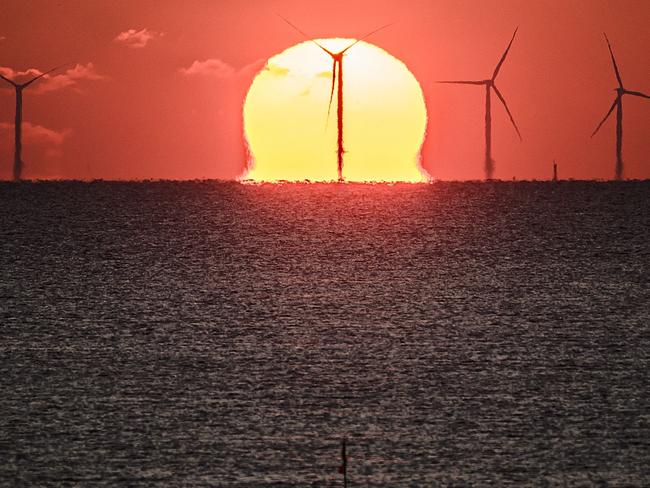Opinion: Why renewable sources of energy aren’t ‘there yet’
Renewables are good when part of an energy mix, but there is a problem that is not up for debate, writes Lars Schernikau.
Opinion
Don't miss out on the headlines from Opinion. Followed categories will be added to My News.
If a movie were made around the modern energy debate, coal wouldn’t be cast as one of the good guys.
Such is the state of the energy debate on this planet, I’m half-expecting the next James Bond film to star a coal baron working with a gang of oil and gas fossil fuel supervillains.
This story is part of The Courier-Mail’s special Future Queensland: Resources series that reveals the truth about the contribution the much-maligned resources industry makes to Queensland.
The series is supported by Bravus, Whitehaven Coal, Queensland Resources Council, the Queensland Government, Senex, Coal Australia and Australian Energy Producers. You can read all of our coverage here
The truth is that energy does not take ethical or political sides.
There are more and less efficient types of “production” of energy, with differing environmental impacts, at different stages of the process.
But it’s all just electrons powering our lives at the end of the day… electrons available and used on demand, when needed.
People want accessible, reliable and affordable energy, and they would rather it little impact the environment. Rarely do we think about the details.
In the debate as complex as the modern energy landscape, where the facts are increasingly deceptive, the “fossil fuels v wind and solar” debate has emerged as an entirely false choice.
Diversification of energy is a good thing. “Renewables” are good when part of a mix, but the problem with wind and solar lies in physics and energy economics that is not up for debate: low energy density, unpredictable nature of their intermittency, and short operational lifetime. These attributes of wind and solar contribute to them having the highest system cost of any “primary energy source”.
Even if you had access battery technology that can store large amounts of energy, cheaply, for long periods of time (spoiler alert, it doesn’t yet exist), the wind and solar path requires significant “overbuilding” to manage nature’s unpredictability, which requires vasts amount of raw materials and more importantly “input energy” to build all this.

Like California, Australia is one of the best places on earth to generate solar power, however, even in these favourable circumstances, completed solar panels operate roughly on a 25 per cent natural capacity factor. That is to say, that solar panels are getting usable sunlight to generate electricity for about one quarter of the time, on average over a year, and “average” is the important word.
Storms, clouds, rain and even snow and sandstorms happen from time to time – and let’s not forget that it’s dark for half the day.
To overcome this solar panels need to be overbuilt by multiple times in some cases over 100x to overcome the natural capacity factor, to make up for storage and transmission losses, and most importantly to charge the storage for days ahead with little useful wind and sun (in Germany we call these “Dunkelflaute”). In a country like Australia, we have already seen what happened in Victoria when sustained bad weather meant the wind and solar network was simply unable to generate enough electricity.
In steps our hero, storage. Well, not quite. When using a battery, you’ll “lose” about 15-20 per cent of the electricity generated simply to move it in and out of a battery and keep it there for some time. Batteries are heavy (low energy density) and require again raw materials and lots of energy to be built. A 500kg Tesla battery “stores” about as much energy as a 30kg piece of coal holds (85kWh).

There are simply not enough mines being licenced around the world to make enough batteries for all the cars, solar panels and infrastructure changes that are required. Batteries don’t last long, degrade (check your phone), and disposal also impacts the environment.
So finally, we turn to hydrogen. The proposition is to make, transport, store and repower Hydrogen to store intermittent wind and solar power. The problem is that you lose up to 80 per cent of the “input energy”, wasting a scarce resource. Keep in mind that “energy is never lost”, only transformed from one from to another, thus any energy “lost” means actually contributing to warming the biosphere around you.
. Maybe coal and gas aren’t the villain after all, when it comes to electricity.
Reliability is an undervalued quality in our current energy debate and pushing for wind and solar + hydrogen system logically has to lead to higher costs and less reliability.
Governments need to take a pragmatic view on the energy mix, so the lights can stay on so that we can wean off fossil fuels in the long run. We need to invest in R&D to find truly economically and environmentally viable long-term solution, I call it the “New Energy Revolution”.
Until then we better invest in our existing electricity systems (including coal, gas, nuclear, hydro, geothermal, etc) to power human and industrial progress and to take billions out of poverty. Deifying “renewables” and demonising coal in this energy quandary helps nobody.
Dr Lars Schernikau is an energy economist, entrepreneur, commodity trader and author
More Coverage
Originally published as Opinion: Why renewable sources of energy aren’t ‘there yet’




